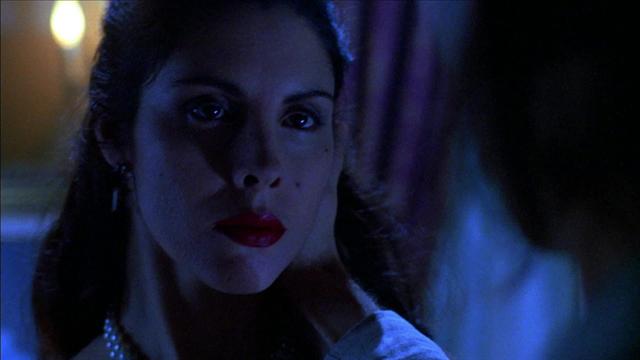 |
| "Who knew this box, would be such a hit" |
The fact that Atkins went in even further than before to explain the back story to Pinhead and his origins is again commendable, but sadly this new information totally contradicts the three films before it. None of the main characters in the prior entries were related to Merchant, so why did their fate have them come in contact with Pinhead? Also what about the multiple boxes that Dr. Channard had in his office from the second film? If these boxes act as portals, what makes you think destroying one box will keep Pinhead out forever? It just doesn't add up. Along with that is a new pseudo-villain named Angelique (Valentina Vargas) who also has a past with Merchant, but only him. Of the characters in the story, the only people that matter and viewers will enjoy is Dr. Merchant, Angelique and Pinhead. Bruce Ramsay (who ends up playing different versions of himself) manages to at least be competent in his role and certainly more convincing than Terry Farrell from the previous movie. As for Vargas and Bradley, they both looked like they enjoyed their roles. Doing all kinds of evil acts and such.
On the flip side, the rest of the cast is completely forgettable. There is no character development, not even for Rimmer who listens to Dr. Merchant. There's also a young Adam Scott and an older Kim Myers (from A Nightmare on Elm Street 2: Freddy's Revenge (1985)) and they too have no real significant importance. But aside from characters, Atkins did change a number of things for the better. One being the tone; the third movie had a completely different tone to that of the first two. Many fans took it as too goofy and cheesy where Pinhead was portrayed more as a generic slasher villain. Here, Pinhead still kills just cause, but he's not as blood hungry either. Another plus is the creativeness of the cenobite designs, which unlike the third film looked quite gimmicky. Here, they look more like what Pinhead's followers would look like. Then again, fans may also complain because there really isn't a lot of new additions. Throughout the whole film, only three new cenobites appear of which one wasn't even human and they also don't receive a lot of screen time. Along with that is a possible dislike for the smaller amount of gore too. With that it may not be as scary either.
 |
| Angelique (Valentina Vargas) |
It still doesn't anywhere match the first two original movies and most will probably find it equal to that of the Hellraiser III: Hell on Earth (1992) quality, but even for the production troubles that it had and nonsensical story telling, it can be a more entertaining watch. Although the likable cast is few, it is made up with more back-story, a better-written tone, appropriate costume design, acceptable special effects that don't look dated and a better film score.
Points Earned --> 5:10
No comments:
Post a Comment